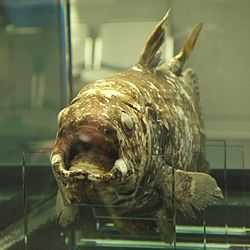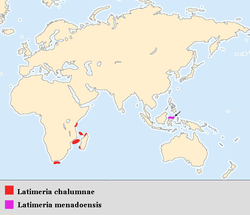Indonesian coelacanth
| Indonesian coelacanth Temporal range: Holocene, 0Ma | |
|---|---|
 | |
| A preserved specimen of Latimeria menadoensis, displayed in Tokyo Sea Life Park (Kasai Rinkai Suizokuen), Japan | |
| Conservation status | |
| Scientific classification | |
| Kingdom: | Animalia |
| Phylum: | Chordata |
| Class: | Sarcopterygii |
| Order: | Coelacanthiformes |
| Family: | Latimeriidae |
| Genus: | Latimeria |
| Species: | L. menadoensis |
| Binomial name | |
| Latimeria menadoensis Pouyaud, Wirjoatmodjo, Rachmatika, Tjakrawidjaja, Hadiaty & Hadie, 1999 | |
 | |
| L. menadoensis range in violet | |
The Indonesian coelacanth (Latimeria menadoensis, Indonesian: raja laut) is one of two living species of coelacanth, identifiable by its brown color. It is listed as vulnerable by the IUCN.[1] The other species, L. chalumnae (West Indian Ocean coelacanth) is listed as critically endangered.[2]
Discovery

On September 18, 1997, Arnaz and Mark Erdmann, traveling in Indonesia on their honeymoon, saw a strange fish enter the market at Manado Tua, on the island of Sulawesi.[3] Mark thought it was a gombessa (Comoro coelacanth), although it was brown, not blue. An expert noticed their pictures on the Internet and realized its significance. Subsequently, the Erdmanns contacted local fishermen and asked for any future catches of the fish to be brought to them. A second Indonesian specimen, 1.2 m in length and weighing 29 kg., was captured alive on July 30, 1998.[4] It lived for six hours, allowing scientists to photographically document its coloration, fin movements and general behavior. The specimen was preserved and donated to the Museum Zoologicum Bogoriense (MZB), part of the Indonesian Institute of Sciences (LIPI).[3]
DNA testing revealed that this specimen differed genetically from the Comorian population.[5][6] Superficially, the Indonesian coelacanth, locally called raja laut ("King of the Sea"), appears to be the same as those found in the Comoros except that the background coloration of the skin is brownish-gray rather than bluish. This fish was described in a 1999 issue of Comptes Rendus de l'Académie des sciences Paris by Pouyaud et al. It was given the scientific name Latimeria menadoensis.[7] In 2005, a molecular study estimated the divergence time between the two coelacanth species to be 40–30 mya.[8]
On November 5, 2014 a fisherman found the species in his net. It was the seventh Indonesian coelacanth found in Indonesian water since 1998.[9]
References
| Wikimedia Commons has media related to Latimeria menadoensis. |
| Wikispecies has information related to: Indonesian coelacanth |
- ↑ 1.0 1.1 Erdmann, M. (2008). "Latimeria menadoensis". IUCN Red List of Threatened Species. Version 2013.2. International Union for Conservation of Nature. Retrieved 2013-12-23.
- ↑ Musick, J. A. (2000). "Latimeria chalumnae". IUCN Red List of Threatened Species. Version 2013.2. International Union for Conservation of Nature. Retrieved 2013-12-23.
- ↑ 3.0 3.1 Jewett, Susan L., "On the Trail of the Coelacanth, a Living Fossil", The Washington Post, 1998-11-11, Retrieved on 2007-06-19.
- ↑ Nelson, Joseph S. (2006). Fishes of the World. John Wiley & Sons, Inc. ISBN 0-471-25031-7
- ↑ Erdmann, Mark V. (April 1999). "An Account of the First Living Coelacanth known to Scientists from Indonesian Waters". Environmental Biology of Fishes (Springer Netherlands) 54 (#4): 439–443. doi:10.1023/A:1007584227315. 0378-1909 (Print) 1573-5133 (Online). Retrieved 2007-05-18.
- ↑ Holder, Mark T., Mark V. Erdmann, Thomas P. Wilcox, Roy L. Caldwell, and David M. Hillis (1999). "Two living species of coelacanths?". Proceedings of the National Academy of Sciences of the United States of America 96 (22): 12616–12620. doi:10.1073/pnas.96.22.12616. PMC 23015. PMID 10535971.
- ↑ Pouyaud, L., S. Wirjoatmodjo, I. Rachmatika, A. Tjakrawidjaja, R. Hadiaty, and W. Hadie (1999). "Une nouvelle espèce de coelacanthe: preuves génétiques et morphologiques". Comptes Rendus de l'Académie des sciences Paris, Sciences de la vie / Life Sciences 322 (4): 261–267. doi:10.1016/S0764-4469(99)80061-4. PMID 10216801.
- ↑ Inoue J. G., M. Miya, B. Venkatesh, and M. Nishida (2005). "The mitochondrial genome of Indonesian coelacanth Latimeria menadoensis (Sarcopterygii: Coelacanthiformes) and divergence time estimation between the two coelacanths". Gene 349: 227–235. doi:10.1016/j.gene.2005.01.008. PMID 15777665.
- ↑ Gabriel Wahyu Titiyoga (November 15, 2014). "Another Pre-Historical Fish Caught in Sulawesi Water".
